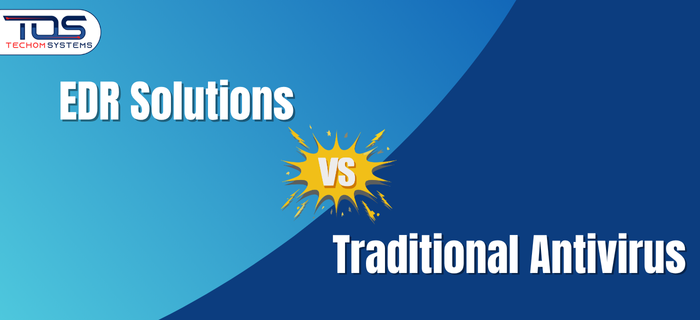In today’s digital world, many businesses face more cyber threats than ever before. Keeping your data and systems safe is a top priority. This is exactly where Endpoint Detection and Response becomes important. In this blog, we will explain what Endpoint Detection and Response means, how it works and why it is so important for modern business security.
If you want to learn about the latest endpoint security solutions and how to identify information security threats before they cause damage, this blog is for you. By the end, you will understand why every business should consider using managed Endpoint Detection and Response to protect their data and reputation.
What Is Endpoint Detection and Response?
When it comes to protecting your business from cyber-attacks, understanding what Endpoint Detection and Response (EDR) really means is important. EDR is a type of cybersecurity technology that keeps a close watch on devices like laptops, desktops and servers. Its main job is to find and stop advanced threats that try to sneak into your systems.
Traditional antivirus software mainly looks for malware it already knows about. But EDR solutions go a step further. They keep an eye on your devices all the time, watching for anything unusual or suspicious as it happens.
This way, they can spot attacks early and stop them before they cause any damage. That’s why EDR is such an important part of a strong security plan.
Here are some important features of Endpoint Detection and Response:
- Continuous monitoring of all endpoints to detect threats early.
- Real time analysis of suspicious activity to identify attacks.
- Automatic response to stop or isolate threats before damage occurs.
- Detailed reporting and alerts to keep your IT team informed.
- Integration with other endpoint security solutions for better protection.
You May Also Like: Struggling with Endpoint Security? Here’s How Hexnode UEM Solves It
How Endpoint Detection and Response Works to Protect Your Business?
Knowing how endpoint detection and response works can help businesses see why it is so important for security. EDR solutions constantly collect information from devices like laptops and servers. They use smart technology and threat knowledge to study this data and spot anything unusual.
When the system finds strange activity, it does not wait. It investigates right away and acts. This might mean isolating the device that has the problem or sending an alert to the security team. This quick response helps catch threats early and keeps damage to a minimum.
Here are some ways how endpoint detection and response work to protect your business:
- Collect data from all endpoints all the time for complete monitoring.
- Use advanced algorithms and threat intelligence to identify risks.
- Automatically investigate suspicious activity without delay.
- Act like isolating affected devices or alerting IT teams.
- Provide real time alerts so teams can react fast.
- Offer detailed incident reports to help understand and fix problems.
- Include features like automated threat hunting to find hidden threats.
With these features, endpoint detection and response become a powerful part of any business security plan.
Also Like: UEM: Unified Endpoint Management – An Essential Guide
EDR Solutions vs Traditional Antivirus

Many people wonder what the difference is between EDR solutions and traditional antivirus software. While antivirus mainly looks for and removes malware it already knows about, endpoint detection and response go beyond that.
EDR constantly watches how endpoints behave. This means it can find new and unknown threats like zero-day attacks or fileless malware that antivirus might miss. Because of this, EDR solutions offer stronger protection against today’s advanced cyber-attacks.
For Australian businesses facing more complex threats, here is why EDR is better:
- Detects not just known malware but also new and hidden threats.
- Monitors the behavior of devices to spot anything unusual.
- Responds to threats in real time to stop attacks faster.
- Helps identify information security threats quickly and accurately.
- Adds a powerful extra layer of defense beyond antivirus.
Combining endpoint detection and response with traditional antivirus gives your business a stronger way to identify information security threats early. This helps you stop attacks before they cause damage and keeps your digital environment safe and secure.
EDR Solutions vs Traditional Antivirus: A Quick Comparison
To better understand the difference between traditional antivirus software and modern EDR solutions, here is a simple comparison table. This will help you see why endpoint detection and response is a stronger, more proactive approach to business security in today’s digital world.
| Feature | Traditional Antivirus | EDR Solutions |
|---|---|---|
| Threat Detection | Detects known malware using signature-based methods | Detects known and unknown threats, including zero-day attacks |
| Behavior Monitoring | Limited or no behavior monitoring | Constant monitoring of endpoint behavior |
| Real-Time Response | Typically reacts only when malware is found | Responds instantly to suspicious activity or attacks |
| Advanced Threat Handling | Cannot detect fileless malware or advanced threats | Handles complex threats like fileless and multi-stage attacks |
| Forensics and Reporting | Basic or no incident insights | Detailed incident analysis and reporting |
| Automation and Alerts | Minimal automation | Real-time alerts with automated threat response |
| System Integration | May work independently | Integrates with other security tools for better coverage |
Understanding Managed Endpoint Detection and Response
Many businesses lack in-house expertise in managing complex security systems. This is where Managed Endpoint Detection and Response services become invaluable. Managed EDR means outsourcing the monitoring and response of endpoint threats to specialized IT security providers like TECHOM Systems.
With managed EDR, businesses benefit from expert protection 24/7 without needing to hire dedicated security staff. This approach is cost effective and ensures continuous vigilance against evolving threats.
Here are the main benefits of managed endpoint detection and response:
- 24/7 expert monitoring and threat response.
- Cost savings compared to building an in-house security team.
- Faster detection and action on potential threats.
- Access to the latest security tools and technology.
- Peace of mind knowing your endpoints are always protected.
By choosing managed EDR, businesses can focus on their core work while staying secure in today’s digital landscape.
How To Identify Information Security Threats Early?
One of the best things about endpoint detection and response is its ability to spot threats early, before they become serious problems. EDR systems work looking closely at endpoint logs, device behavior and network activity to find anything suspicious.
Catching threats early means your business can act quickly and reduce the chance of damage or data loss. To get the most protection, it is a good idea to use EDR tools together with strong security habits.
Here are some keyways to identify information security threats early:
- Analyze logs and behavior on all endpoints continuously.
- Monitor network activity for unusual patterns.
- Use automated alerts to catch suspicious events fast.
- Combine EDR with employee training on security best practices.
- Keep your systems updated regularly to close vulnerabilities.
Using endpoint detection and response in this way helps keep your business safe and secure.
Why Endpoint Detection and Response Is Essential For Aussie Businesses?
Cybercrime is becoming more common in Australia, it affects businesses of all sizes. That is why using endpoint detection and response is no longer a choice but a must. EDR helps businesses stay ahead of attackers and meet important data protection laws.
By using EDR solutions, Aussie companies can take a proactive approach to cybersecurity. These tools help protect your business data, keep your systems running smoothly and build trust with your customers.
Here are a few reasons why endpoint detection and response is important for Australian businesses:
- Protects against both known and unknown cyber threats.
- Helps meet local data protection and privacy rules.
- Supports business continuity by stopping attacks early.
- Boosts customer confidence through stronger security.
- It makes it easier to identify and respond to security threats quickly.
Using endpoint security solutions like EDR tools is one of the best ways for Australian businesses to stay safe in today’s digital world.
How To Choose The Right Endpoint Security Solutions?
Choosing the right endpoint security solutions is important for protecting your business from cyber threats. With so many options available, it is helpful to focus on what matters most to your specific needs.
A well-chosen endpoint detection and response tool should not only protect your systems but also fit easily into your current setup.
Here are some key points to keep in mind:
- Easy To Deploy and Manage
Look for a solution that is simple to install and does not require complex steps to use. - Scalability
Make sure the EDR solution can grow with your business as your team and network expand. - Good Integration
The tool should work well with your existing IT systems, making it easier to manage everything from one place. - Regular Updates and Strong Support
Pick a solution that offers frequent updates and reliable customer support to keep your security up to date. - Cost Effectiveness
Your chosen EDR tools should offer good value for money without compromising on features or protection.
Selecting the right EDR solutions that match your business goals can make a big difference in keeping your data safe and reducing risks.
Frequently Asked Questions (FAQs)
#1 What is an Example of an EDR?
An example of an EDR solution is CrowdStrike Falcon, which continuously monitors and responds to threats on your devices in real time. Other well-known EDRs include Microsoft Defender and Sentinel One.
#2 How Is EDR Different from Antivirus?
Unlike antivirus that only detect known malware, EDR watches device behavior to find new and hidden threats, giving stronger protection against advanced attacks.
#3 What Is the EDR Process?
EDR continuously monitors endpoints, detects suspicious activity using smart algorithms, responds instantly to threats and provides detailed reports to keep your business safe.
#4 What is EDR and Why is It Important?
EDR (Endpoint Detection and Response) protects your business from modern cyber threats by spotting and stopping attacks early. TECHOM Systems offers managed EDR services to help Australian businesses stay secure effortlessly.
Final Thoughts
Endpoint detection and response is no longer just a nice-to-have. It has become a must for every Australian business that wants to take cybersecurity seriously. As cyber threats continue to grow more complex, relying only on traditional antivirus tools is simply not enough.
With the right EDR solutions, your business can move from a reactive approach to a proactive one. These tools help you identify information security threats early, respond faster and reduce the risk of data loss or downtime.
Ready To Boost Your Cybersecurity with Powerful Endpoint Detection and Response?
Talk to the experts at TECHOM Systems and find the right EDR solution for your business today.
Joe thrives at the intersection of technology and team productivity. With 8+ years in IT operations, cloud infrastructure and modern-driven process improvement, she excels at transforming complex systems into organized, manageable workflows. Joe’s real strength lies in helping teams make sense of technical environments, clarifying cloud deployments, streamlining IT processes and ensuring AI tools are applied effectively. Her approachable guidance and structured communication reduce confusion, boost collaboration and make technical innovation feel achievable. Joe believes technology works best when it empowers people, not complicates their work.







